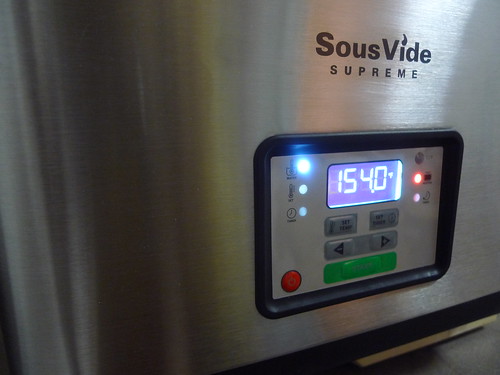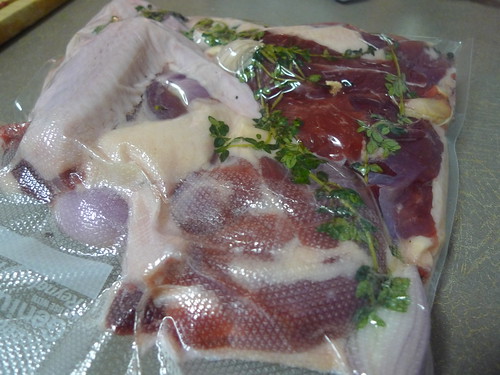I’ve been M.I.A. for the last seven and a half weeks so it’s great to be writing again. I’m now moved in to my new apartment–all boxes have been unpacked and the contents reorganized. I’m extra proud of my kitchen because I’ve made it my own even though I had to work with a lot of limitations (co-op rules and, not to mention, my dwindled budget). After sixteen years in New York City, I’m glad to finally call something my own.
When the SousVide Supreme was delivered to my door, I was afraid to open up yet another box of something. It sat in the kitchen with all my other stuff until I was finally comfortable enough to cook amid the chaos. It was honestly the perfect machine for someone as busy and scattered as I was. All I had to do was fill it with enough water to submerge the vacuumed-sealed meat I was about to cook, set the recommended temperature and wait for it to be ready. The whole time I was “waiting”, I was finishing tasks I had to do, cleaning up around me and living my usual routine of work and sleep. The only heavy lifting involved is vacuum-sealing and setting aside the time to submerge the meat and remember to remove and eat it.
If you watch Top Chef, you’ve seen enough sous-vide cooking in the last year. It’s French for “under vacuum” and it’s cooking vacuum-sealed anything in a water bath set to a very low temperature. The cooking time is longer, but the temperature is consistent which may give you the impression that you really can’t mess anything up. You still can, as evidence to my duck breast story below, but with enough practice, you too can impress Thomas Keller with how evenly-cooked sous-vided meats are. (There’s your new word of the year: sous-vided!) For those who love their grill marks and roast smell–and don’t we all?–you can finish cooking by searing the meats before serving. It’s an extra step but could be worth it for presentation purposes and peace of mind.
My main concern is how much vacuum-seal bags you need to purchase when you get into this whole sous-vide craze. You’d have to buy yet another gadget for your kitchen to seal whatever you want to sous-vide, and with every piece of meat or vegetable you have to make sure that you have a bag in stock. One just has to weigh the costs of vacuum-seal bags for sous-vide against the energy spent cooking if you do it the regular way. It may be worth it if you don’t ever want to worry about correctly roasting a whole chicken ever again.
For our first try, the Dr. picked up a whole duck (I didn’t have the free time!) and we invited two of our favorite people over for dinner. The night before, we minced and mixed all the marinade ingredients together and put them all in the bag with the duck breast and the legs. Fresh thyme, bay leaves, onions and garlic with some salt and pepper were all we need. Our mistake was putting all the duck pieces in one bag. I don’t know what came over us; we’ve cooked many ducks before and it still baffles me why we didn’t think of separating the pieces so that we could remove the duck breast from the water bath hours earlier than the legs. The legs came out nicely, like confit, but the breast was tasteless and dry because we had overcooked it. Alas, there is still such a thing as overcooking even with the SousVide Supreme.
With the duck, we also sous-vided fennel, Brussels sprouts, parsnips and roasted beets. I don’t think we would have noticed the difference if we just roasted the vegetables like we usually do, but it certainly didn’t hurt that we added them in the mix.
If it ruined our duck breast, I wondered what it would do to chicken breast. I mixed some of the herbs and spices I already had in my cupboard and sous-vided four boneless chicken breasts for almost five hours. The result was very moist meat that stayed moist even after two days in the fridge. We ate the chicken as they were that night, but ate the leftovers the day after and the next and I couldn’t believe how moist they still were. Just for that, I would love to own my own SousVide Supreme so I can begin to love chicken again.
If there is one thing I need to correct when I sous-vide chicken however, it would be to make small incisions all over the meat before I seal them in a bag. Although cooked for several hours, there was still a watery bloodbath as soon as we sliced the meat the first time. This was no big deal to me but it could turn off a lot of diners.
I’ve also had sous-vide eggs before and I wanted to recreate how full and yellow the yolks were while the whites stayed delicately soft. Sure it’s easier and quicker to just soft-boil them, but with the SousVide Supreme, there is no need to worry that your soft-boiled eggs will become hard-boiled eggs. They were perfectly custardy and set beautifully against frisée and mixed greens. Is it worth spending an hour cooking eggs? Probably not, but you’d have to be a super geek about your food to appreciate how pretty soft-boiled eggs could be.
We unfortunately didn’t have enough time to try it with beef, lamb or pork which was inexcusable because I actually already had Korean beef ribs marinating in the fridge. I had to return the SousVide Supreme back to its rightful owners. Clean-up was almost non-existent. I poured out the water and wiped the inside of the machine dry with a kitchen towel. It as fun as long as it lasted.
Did I mention that I just moved in to a new apartment and could use a housewarming present? I have the perfect counter space for it.
Related post/s:
Welcome to my new home in Harlem, New York
Recommended tool/s:
The SousVide Supreme is available for you home cooks for under $500













